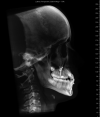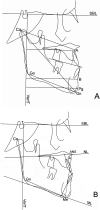Comparison of two protocols for maxillary protraction: bone anchors versus face mask with rapid maxillary expansion
- PMID: 20578848
- PMCID: PMC2930261
- DOI: 10.2319/111709-651.1
Comparison of two protocols for maxillary protraction: bone anchors versus face mask with rapid maxillary expansion
Abstract
Objective: To test the hypothesis that there is no difference in the active treatment effects for maxillary advancement induced by bone-anchored maxillary protraction (BAMP) and the active treatment effects for face mask in association with rapid maxillary expansion (RME/FM).
Materials and methods: This is a study on consecutively treated patients. The changes in dentoskeletal cephalometric variables from start of treatment (T1) to end of active treatment (T2) with an average T1-T2 interval of about 1 year were contrasted in a BAMP sample of 21 subjects with a RME/FM sample of 34 patients. All subjects were prepubertal at T1. Statistical comparison was performed with t-tests for independent samples.
Results: The BAMP protocol produced significantly larger maxillary advancement than the RME/FM therapy (with a difference of 2 mm to 3 mm). Mandibular sagittal changes were similar, while vertical changes were better controlled with BAMP. The sagittal intermaxillary relationships improved 2.5 mm more in the BAMP patients. Additional favorable outcomes of BAMP treatment were the lack of clockwise rotation of the mandible as well as a lack of retroclination of the lower incisors.
Conclusions: The hypothesis is rejected. The BAMP protocol produced significantly larger maxillary advancement than the RME/FM therapy.
Figures




References
-
- Jacobson A, Evans W. G, Preston C. B, Sadowsky P. L. Mandibular prognathism. Am J Orthod. 1974;66:140–171. - PubMed
-
- Guyer E. C, Ellis E. E, III, McNamara J. A, Jr, Behrents R. G. Components of Class III malocclusion in juveniles and adolescents. Angle Orthod. 1986;56:7–30. - PubMed
-
- Kerr W. J, TenHave T. R. Mandibular position in Class III malocclusion. Br J Orthod. 1988;15:241–245. - PubMed
-
- Battagel J. M. The aetiological factors in Class III malocclusion. Eur J Orthod. 1993;15:347–370. - PubMed
-
- De Toffol L, Pavoni C, Baccetti T, Franchl L, Cozza P. Orthopedic treatment outcomes in Class III malocclusion. Angle Orthod. 2008;78:561–573. - PubMed
Publication types
MeSH terms
Grants and funding
LinkOut - more resources
Full Text Sources

